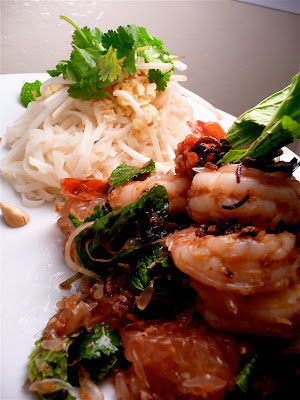 I had to do a bit of research to see what I should name my creation, but I think I've settled on tortino di pasta. At first I was going to call it a timballetto (a little timballo, or a little kettle-drum), but it's not too 'kettle-drummy.' Then again, depending on where you eat a timballetto, as with so many other Italian dishes, how it looks and tastes can vary greatly. A quick trip to the wiki-cloud informs us that the dish in Emilia-Romagna (where it's known as a bomba) "is filled with game bird, peas, cheese and a base of dried pasta or rice. In Abruzzo, they use crepes as a base, and other regions use ravioli or gnocchi."
I had to do a bit of research to see what I should name my creation, but I think I've settled on tortino di pasta. At first I was going to call it a timballetto (a little timballo, or a little kettle-drum), but it's not too 'kettle-drummy.' Then again, depending on where you eat a timballetto, as with so many other Italian dishes, how it looks and tastes can vary greatly. A quick trip to the wiki-cloud informs us that the dish in Emilia-Romagna (where it's known as a bomba) "is filled with game bird, peas, cheese and a base of dried pasta or rice. In Abruzzo, they use crepes as a base, and other regions use ravioli or gnocchi." Whatever you call it and however you slice it, the inspiration for my little lasagna pie was most certainly this famous dish, known as "timpano":
I must say a few things about this movie and what it represents. I had been working in an Italian restaurant in Santa Cruz for some three years before one of my customers told me to see Big Night. I had never even heard of it at the time, but it has become one of my favorite movies. The scene where the customer wants a side of pasta for her risotto, and Stanley Tucci has to explain why that doesn't jive with la cucina Italiana. I lived this scene everyday I worked at Cafe Mare! In case you haven't seen the movie, Tucci eventually gives in to the ubiquitous and almighty power of the pushy, paying American customer and has to ask his brother the chef, played by Tony Shalhoub, to make a side of pasta for her risotto. Shalhoub, as many Italian chefs would, refuses to do so! Until, that is, Tucci holds open the door that leads into the dining room where the ugly American is staring impatiently back into the kitchen. Tucci says to his brother "you don't-ah make-ah di pasta...ah-fine! You go tell her." "O.K." Shalhoub pulls back, "I make-ah di pasta." You don't know how many times I wanted to march the chef out to my tables.
 In the end, though, I respect the integrity of these stubborn Italian chefs. It's not limited to the chefs either. Italians in general tend to be quite sure of what is acceptable (and when it is acceptable) to eat and drink. In the morning, for example, a proper cappuccino is standard fare. After 10:30, a cappuccino??!! Absolutely not. You want parmigiano cheese on your seafood pasta??!! I am sorry, I will not do that. Now being an American, I don't typically like to abide by rules or follow tradition (other than the tradition to not follow rules, of course) so sometimes I butt heads with these rigid guidelines. But these "food laws" aren't usually put into place just 'cause. They often make sense! If you pile a bunch of cheese on your seafood, all you're going to taste is cheese.
In the end, though, I respect the integrity of these stubborn Italian chefs. It's not limited to the chefs either. Italians in general tend to be quite sure of what is acceptable (and when it is acceptable) to eat and drink. In the morning, for example, a proper cappuccino is standard fare. After 10:30, a cappuccino??!! Absolutely not. You want parmigiano cheese on your seafood pasta??!! I am sorry, I will not do that. Now being an American, I don't typically like to abide by rules or follow tradition (other than the tradition to not follow rules, of course) so sometimes I butt heads with these rigid guidelines. But these "food laws" aren't usually put into place just 'cause. They often make sense! If you pile a bunch of cheese on your seafood, all you're going to taste is cheese.Italians, like so many other peoples around the world, take their cuisine seriously. When executed properly, it is elevated to artistic masterpiece. That's what the timpano ends up being in Big Night, a culinary masterpiece. But I shall digress. On to my tortino di pasta.
I'm not sure that my tortino reached piece de resistence status, but it did come out pretty darn good. The ingredients I used were identical to many a lasagna recipe; onions, garlic, ground beef, tomato sauce, spinich, ricotta, pecorino, lasagna noodles. The only difference really is the layering; layer of noodles, layer of meat/spinach, layer of cheese, layer of meat/spinach, layer or noodles, done. All of this takes place in a pie dish, by the way. The simplest savory tortino di pasta ever. I oiled the top layer of noodles and covered it with foil. I baked it at 350° for 30 minutes, turned it out onto a plate, and let it rest for 5 minutes or so. Slice, serve, smile. Come sei bello il mio tortino.



















